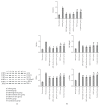Effects of Qingshen Granules on the Oxidative Stress-NF/kB Signal Pathway in Unilateral Ureteral Obstruction Rats
- PMID: 29576795
- PMCID: PMC5822778
- DOI: 10.1155/2018/4761925
Effects of Qingshen Granules on the Oxidative Stress-NF/kB Signal Pathway in Unilateral Ureteral Obstruction Rats
Abstract
Background. The activation of NF-kappa B (NF/kB) signaling pathway plays an important role in the process of epithelial-mesenchymal transition (EMT) and renal interstitial fibrosis (RIF) in renal tubules. The process of oxidative stress reaction in kidney is via excessive reactive oxygen species (ROS) production to activate NF/kB signaling pathway. Qingshen Granule (QSG) is an effective Chinese formula utilized to treat chronic renal failure. Previous studies confirmed that QSG could inhibit RIF in unilateral ureteral obstruction (UUO) rats. In this study, we used UUO rats to investigate the effects of QSG on oxidative stress and the activation of NF/kB signaling. Seventy male Sprague-Dawley (SD) rats were randomly divided into a sham group, UUO model group, Qingshen Granules (QSG) high-dose, medium-dose, and low-dose groups, PDTC group, and candesartan group (10 rats in each group). Our study demonstrated that oxidative stress-NF/kB signal pathway contributed to the formation of UUO renal interstitial fibrosis. QSG may protect against RIF by inhibiting the oxidative stress-NF/kB signal pathway, reducing inflammation, and improving renal tubular EMT.
Figures




References
-
- Rodríguez-Iturbe B., Ferrebuz A., Vanegas V., Quiroz Y., Mezzano S., Vaziri N. D. Early and sustained inhibition of nuclear factor-κB prevents hypertension in spontaneously hypertensive rats. The Journal of Pharmacology and Experimental Therapeutics. 2005;315(1):51–57. doi: 10.1124/jpet.105.088062. - DOI - PubMed
-
- Wang Z., Liang L.-J., Wang C.-H., et al. Effect of shenluotong decoction on renal interstitial fibrosis in rals with obstructive nephropathy. Zhongguo Zhong Xi Yi Jie He Za Zhi. 2014;34(10):1238–1244. - PubMed
-
- Chen Y., Zhu C.-L., Yan R. Protective effect of Cornus officinalis on renal interstitial fibrosis and its mechanism. Tian Ran Chan Wu Yan Jiu Yu Kai Fa. 2015;27(11):1957–1961.
LinkOut - more resources
Full Text Sources
Other Literature Sources

